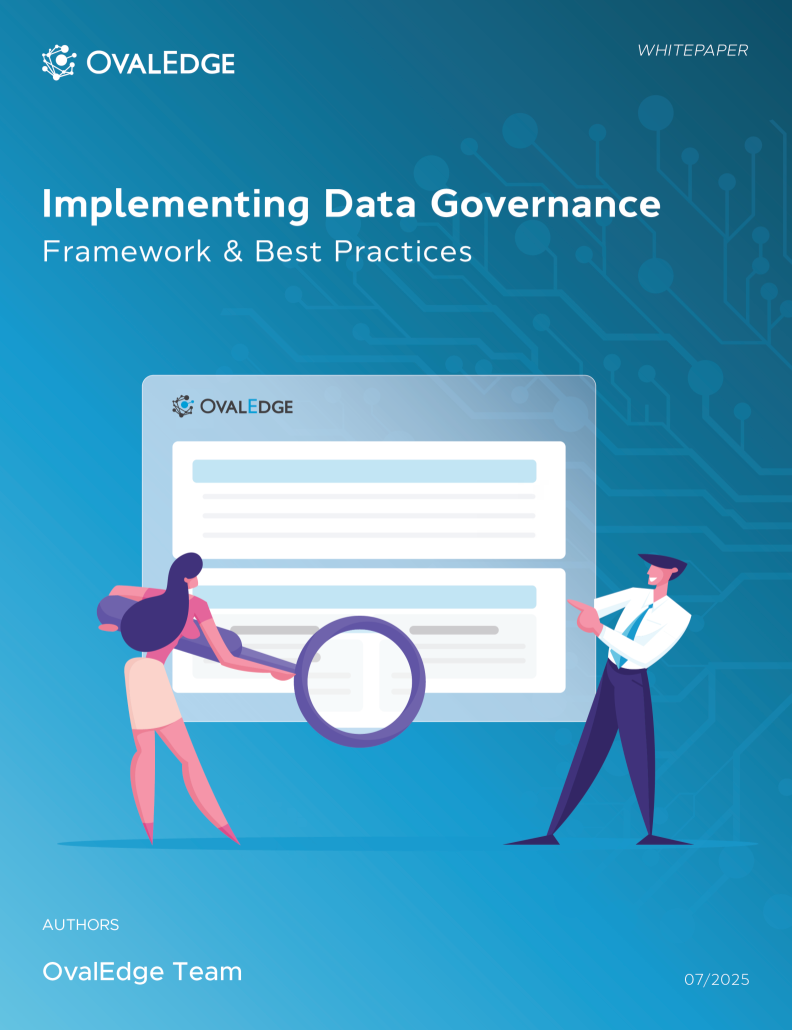Table of Contents
Data Governance Roadmap: A Practical Guide
A Data Governance (DG) roadmap will bring together your drivers, priorities, team members, and capacity and determine how governance will work to drive your organization’s overall data strategy. It will enable you to create realistic goals, define roles, set milestones, and prepare to remove barriers.
As with any significant enterprise commitment, you must have a clear and workable plan for your company's data governance initiative. This plan is best described as a data governance implementation roadmap and must incorporate your intentions and strategies while recognizing your data maturity and capacity.
A Data Governance (DG) roadmap will bring together your drivers, priorities, team members, and capacity and determine how governance will work to drive your organization’s overall data strategy. It will enable you to create realistic goals, define roles, set milestones, and prepare to remove barriers.
As with any significant enterprise commitment, you must have a clear and workable plan for your company's data governance initiative. This plan is best described as a data governance implementation roadmap and must incorporate your intentions and strategies while recognizing your data maturity and capacity.
A Data Governance (DG) roadmap will bring together your drivers, priorities, team members, and capacity and determine how governance will work to drive your organization's overall data strategy. It will enable you to create realistic goals, define roles, set milestones, and prepare to remove barriers.
As with any significant enterprise commitment, you must have a clear and workable plan for your company's data governance initiative. This plan is best described as a data governance implementation roadmap and must incorporate your intentions and strategies while recognizing your data maturity and capacity.
This blog will explain what a data governance strategy and roadmap is, why you need one, how to build one, identify your milestones, and mitigate barriers. You'll learn how a sound data governance strategy will set you up for success and the steps that you need to take to construct a roadmap that will instill a culture of data-driven innovation in your organization.
Successful Data Governance: Critical for Today’s Business
Data governance plays a vital role in modern business operations. The digital revolution has ushered in the data age, and today the most effective method for growth is through data-driven decision-making.
Yet, data governance can be complicated and expensive if not managed correctly. When you embark on a data governance initiative in your organization, you need a roadmap to guide the process.
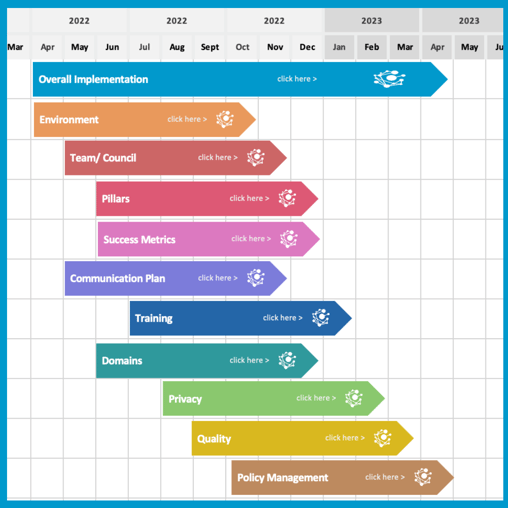
In the modern enterprise, the scope of the data governance strategy has expanded significantly to address the proliferation of Artificial Intelligence (AI) and Machine Learning (ML). Enterprises recognize that data must be treated as a strategic asset not only for reporting but also for powering intelligent automation.
Therefore, a modern data governance implementation roadmap must include specific checks and balances for AI readiness, focusing on data used for model training to prevent bias, ensure explainability, and maintain real-time accountability. Governing these dynamic AI models requires a shift from traditional data governance principles to an interconnected AI governance framework.
Download the Roadmap Template to begin mapping your path to data governance
Having a Solid Data Governance Strategy is Important
When presenting your roadmap, you need to ensure that everyone in the organization can see how the drivers directing them to pursue data governance will be addressed. For example, suppose a primary driver for your organization is an effort to discover what your BI assets are. In that case, your roadmap should include a milestone that ensures your BI assets are collected, defined, and curated.
Common drivers include:
- Agreeing on enterprise definitions
- Instilling confidence in the quality of company data
- Better data literacy
- Tracking PII/PHI and other data
- Knowing which BI assets you have and retiring those no longer in use
- Understanding metrics that appear in BI assets
- Transparency and consistency around metrics in BI assets
- Retiring technical debt
- Upgrading software
- Keeping downstream assets intact.
Next, you need to consider risks and barriers that can impede your program. It would help if you preplanned how to avoid or address these issues as they come up and included an escalation process for the leadership team.
Related: What Is Data Governance? Definition & Best Practices
Common risks and barriers include:
- Unclear roles and responsibilities
- Vague intentions and an inability to generate a strategy
- Issues with tools, lineage, usage, and backlogs
- An inability to put data governance services and processes into production
- Communication problems
- Enterprise engagement issues
- Staffing and capacity barriers
- Executive buy-in and leadership barriers
- Executive knowledge of how to lead data governance
- Undefined success metrics, drivers, and goals
- Preparations for cultural shifts
- Preparing BI teams,
- Indecisive approaches to data governance
- A lack of Compliance, IT, or Business Team participation
Once you understand and prioritize your drivers and have outlined how you will avoid or mitigate risks, you need to establish where you currently are and how you will develop the pillars you need to take your Data Governance program to the next level.
The Roadmap to Good Data Governance
Companies seeking to develop a data governance implementation roadmap generally fall into four stages: grassroots, uni-dimensional or passive, progressive, and fully functional.
At the grassroots stage, one or two people in an organization recognize the need for data governance and evangelize it. There is a small budget for some tools that staff use to the best of their capacity.
At the uni-dimensional stage, commonly known as passive data governance, a tool is deployed by a single team, usually the BI team. All of the brilliance is contained within the individual team, meaning you don't have business members, compliance, quality, infosec, BI developers, security, or architects at the same table, curating terms and managing assets.
Organizations at the progressive data governance stage have adopted a multidimensional approach that includes all company areas. Often beginning with a focus on data literacy, companies continue to progress through data quality, security, and policy. Each committee matures by progressively adding different layers as they gain confidence and master the process.
Related: Data Governance and Data Quality: Working Together
At the fully functioning stage of data governance, a company has matured in progressive data governance and is working to embed curation and governance requirements daily.
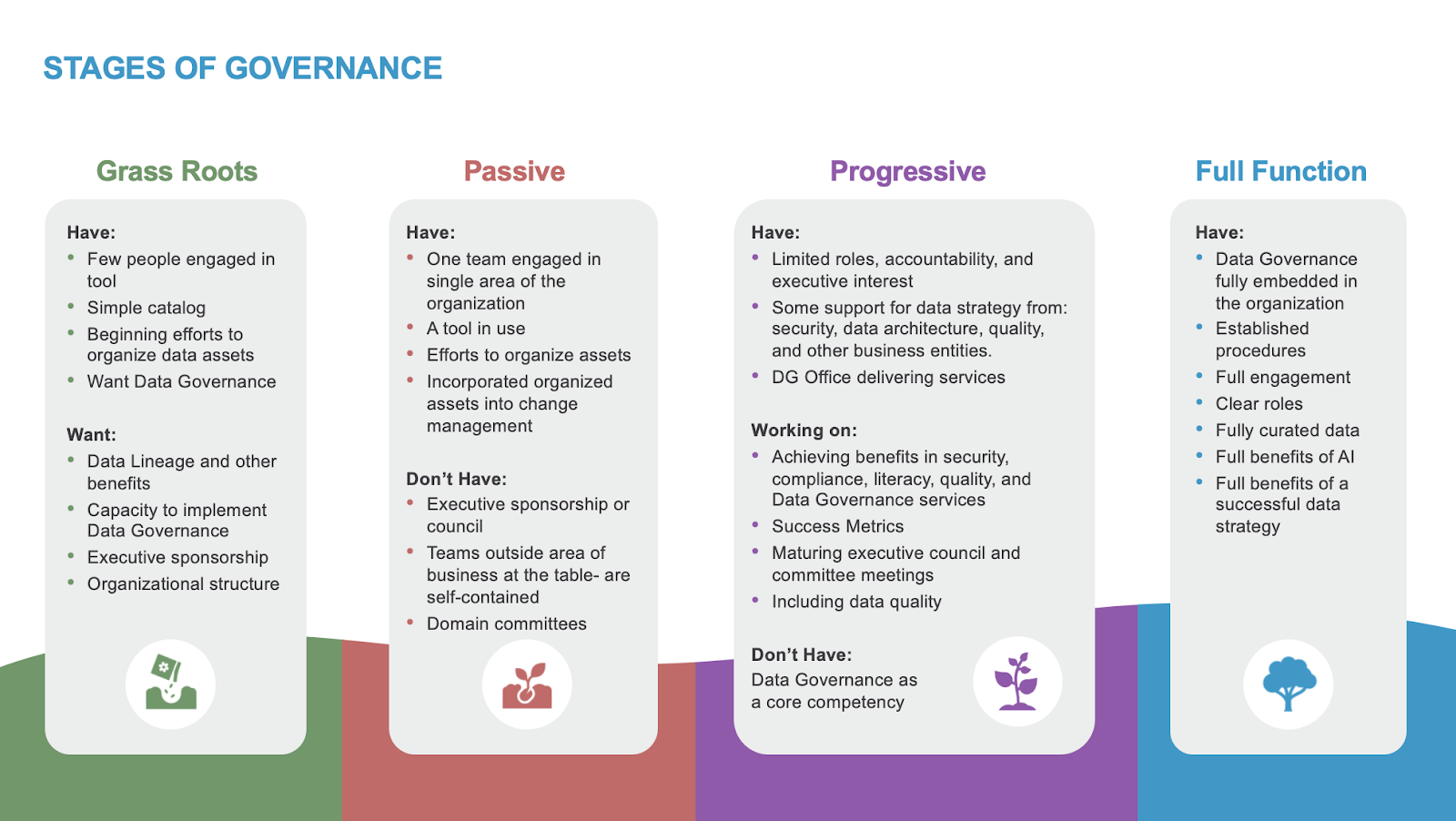
To create a suitable roadmap, you need to establish a starting point. It's fine to have components from more than one of the stages. However, understanding where you are starting from and the various stages in maturing a successful program will help you avoid common pitfalls and clarify your objectives.
Finally, you must consider your organization's capacity. After this, it's time to put your roadmap together. Step one is to establish a Data Governance Office (DGO).
A common challenge for implementing a data governance strategy is justifying the investment. Demonstrating positive ROI secures long-term executive support and positions governance as a business enabler.
The ROI components extend beyond avoided legal fines and include risk mitigation, faster deployment of new data assets, and innovation enablement.
Key Metrics for Measuring ROI
- Risk Mitigation (Loss Aversion): Quantifying avoided compliance penalties, reductions in data breach costs, and lower incident response times.
- Productivity Gains: Measuring the reduction in time employees spend searching for, preparing, or reconciling data (e.g., tracking the percentage of data assets cataloged and governed). Increased self-service access directly contributes to workforce efficiency.
- Data Quality Improvement: Tracking metrics like Data Accuracy Rate, Data Completeness Score, and the reduction in data errors that cause operational hiccups or failed reports. These improvements directly lead to more reliable insights and better decision-making, which in turn drive revenue opportunities.
Building a Data Governance Office
Your Data Governance Office will need to set up a Data Governance Team and Data Governance Committee, pillars, success metrics, communication plan, and training sessions.
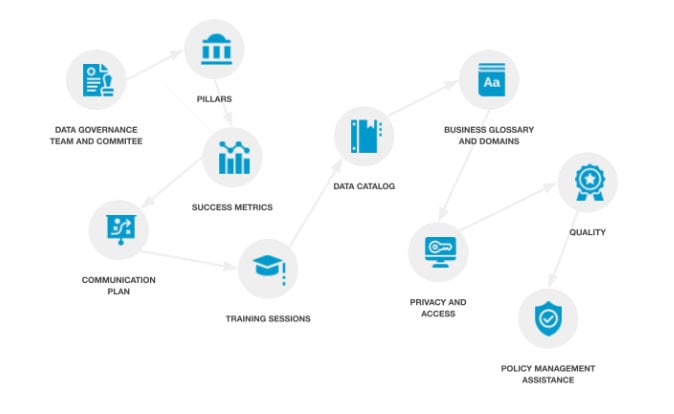
 Data Governance Team and Committee
Data Governance Team and Committee
To begin, you must establish how you will achieve your Data Governance (DG) Team goals by creating a charter document that details the purpose of the team's responsibilities and priorities. This document will identify a lead and support team and clarify goals and milestones.
Your DG Team is also responsible for establishing and providing continuous support to committees.
 Pillars
Pillars
Pillars of data governance outline the services that uphold the governance support your DG team is responsible for delivering to others. They include schema comparisons, scheduling crawls, building lineage, data profiling, and more.
 Success metrics
Success metrics
Identifying your success metrics early will help you organize them so that you can filter them by individual data governance committee. Next, you can group the metrics to see how your overall program progresses.
Each committee should identify goals related to their success metrics, keeping in mind that they may not all start simultaneously and that these goals may change as they mature.
 Communication plan
Communication plan
Your communication plan will determine the areas you want to promote, how the DGO will communicate with governance stakeholders, and how they can expect to communicate with your DG Team. You can also address where people can go if they need or want more information.
 Training sessions
Training sessions
Data governance impacts your company's data handling culture. Because of this, you'll need to train users on how to operate tools for specific roles and provide clarification on data governance concepts and their applications. Your DGO should expect to provide a library of different training for various audiences
Focusing on Core Data Governance Areas
The next stage is to focus on your data catalog, data domains and business glossary, data privacy and access, data quality, and policy management assistance
 Data catalog
Data catalog
When you crawl your data environment, you populate your data catalog with metadata about your assets, displaying tables, field names, and ETLs. The goal is to capture as much of your data ecosystem as possible.
 Business glossary and domains
Business glossary and domains
A business glossary will help you define your critical data elements. Once defined, you can connect them to your data catalog. This step removes much of the confusion on terminology and provides transparency for metrics, sources, and privacy handling.
 Privacy and access
Privacy and access
You should evaluate privacy information handling during the formation of your roadmap. If you plan to expand the capabilities and provide transparency for protected data elements, you can also incorporate these milestones on your roadmap.
 Quality
Quality
Companies manage data quality in many ways, but the key is to evolve from a reactive data quality environment to a proactive one. The goal is not to prioritize quality execution but to improve transparency on data quality issues and their resolutions. For example, you should aim for a date when you will include data quality in the conversation when curating terms and assets.
 Policy management assistance
Policy management assistance
DG Teams will often support how data policies are made available to an organization. Sometimes, policymakers may ask for help from the data governance team to detect policy violators.
Then, the DG Team will help communicate when policy changes have been published and the changes that need to be made within the ecosystem to achieve compliance. The DG Team doesn't make the policies; instead, they provide the organized space for each area of data governance to share.
Steps for a Strong Data Governance Strategy
A successful data governance strategy involves clear, actionable steps. Consider the following strategies when building your governance framework:
1. Assess Your Data Maturity – Evaluate your organization’s current state of data management and identify gaps.
2. Define Governance Objectives – Align goals with business priorities, such as data quality, compliance, or analytics.
3. Establish Roles and Responsibilities – Define accountability across teams with clear ownership of data assets.
4. Develop Data Policies and Standards – Create consistent rules for data access, usage, and classification.
5. Implement a Data Governance Framework – Structure the governance processes and supporting technologies.
6. Measure and Monitor Progress – Use success metrics and KPIs to evaluate your roadmap’s performance.
7. Foster a Data-Driven Culture – Encourage collaboration, communication, and ongoing education across teams.
Translating the Roadmap into a Data Governance Project Plan
While the data governance implementation roadmap is the high-level, multi-year strategic vision, the data governance project plan is the tactical document for achieving the near-term milestones. A typical project plan breaks down the roadmap phases into executable workstreams:
- Discovery and Definition:Conduct a full inventory of critical data elements (CDEs). This initial project phase validates the assumptions made during the strategy development.
- Tooling and Infrastructure Setup: Implement governance tools such as a data catalog, ideally leveraging AI-enabled solutions for automated classification, tagging, and lineage tracking to reduce manual effort and accelerate the process. This automation is critical for any modern data governance project plan.
- Policy Operationalization (Pilot): Execute a pilot project on a single high-value data domain (e.g., customer data). This involves defining, documenting, and enforcing policies and data quality rules for that domain before scaling enterprise-wide.
- Training and Change Management: The project concludes its phase with role-specific training, ensuring Data Owners and Data Stewards understand the new processes and tools. This fosters the cultural shift necessary for long-term success.
Wrap Up
Your data governance implementation roadmap should manage each area of data governance in stages along the way. It doesn't always mean implementing full-function data governance from the start. Assessing your team, capacity, executive buy-in, data maturity, and more will inform the breadth of your roadmap and enable you to decide where you want to be and how you want to get there.
A data strategy roadmap template can help you visualize these steps and ensure alignment with your overall business strategy, guiding you toward a mature, well-structured data governance program.
Frequently Asked Questions
-
How does the rise of AI and Generative AI (GenAI) change a data governance strategy?
The rise of AI necessitates a pivot from traditional data governance (focused primarily on compliance and quality) to AI Governance. A modern strategy must incorporate new policies for data used in model training, including ensuring explainability, monitoring for algorithmic bias, and establishing real-time accountability for AI-driven decisions. Data governance now serves as the trusted foundation for secure and ethical AI deployment.
-
What are the key differences between a Data Governance Roadmap and a Data Governance Project Plan?
A Data Governance Roadmap is a strategic, long-term (1-3 year) visualization that outlines the phased journey and desired business outcomes. A Data Governance Project Plan is a tactical, short-term document that details the specific actions, resources, tasks, and timelines required to achieve a single phase or milestone on the roadmap (e.g., "Phase 1: Implement a Data Catalog").
-
What are the primary metrics to demonstrate a positive ROI for data governance?
ROI for data governance is measured through three types of metrics:
1) Cost Savings (e.g., reduced fines, lower data storage costs due to redundancy elimination),
2) Risk Mitigation (e.g., a higher compliance audit success rate, fewer data breaches), and
3) Value Creation (e.g., faster time-to-market for data products, measurable increase in data quality scores leading to more accurate business forecasts).
-
What role does automation and AI tooling play in the data governance implementation roadmap?
Automation, powered by AI/ML, is essential for scalability. On the data governance implementation roadmap, this typically appears in Phase 2 or 3 (Tooling Implementation) and includes the use of AI for automatic data classification, sensitive data tagging, automated lineage mapping, and proactive data quality monitoring. This shifts the Data Steward's role from manual cleanup to policy oversight.
-
What are 'Data Contracts' and why are they important for modern data governance?
Data Contracts are agreements between a data producer (source system/team) and a data consumer (user/team) that formally define the schema, quality expectations, ownership, and adherence to governance policies for a specific dataset. They are critical for federated data governance models (like Data Mesh) as they enforce standards and quality at the source, preventing downstream data issues and ensuring that governed data is treated as a reliable product.
Book a call with us to find out:
|
OvalEdge recognized as a leader in data governance solutions
.png?width=1081&height=173&name=Forrester%201%20(1).png)
“Reference customers have repeatedly mentioned the great customer service they receive along with the support for their custom requirements, facilitating time to value. OvalEdge fits well with organizations prioritizing business user empowerment within their data governance strategy.”
.png?width=1081&height=241&name=KC%20-%20Logo%201%20(1).png)
“Reference customers have repeatedly mentioned the great customer service they receive along with the support for their custom requirements, facilitating time to value. OvalEdge fits well with organizations prioritizing business user empowerment within their data governance strategy.”
Gartner, Magic Quadrant for Data and Analytics Governance Platforms, January 2025
Gartner does not endorse any vendor, product or service depicted in its research publications, and does not advise technology users to select only those vendors with the highest ratings or other designation. Gartner research publications consist of the opinions of Gartner’s research organization and should not be construed as statements of fact. Gartner disclaims all warranties, expressed or implied, with respect to this research, including any warranties of merchantability or fitness for a particular purpose.
GARTNER and MAGIC QUADRANT are registered trademarks of Gartner, Inc. and/or its affiliates in the U.S. and internationally and are used herein with permission. All rights reserved.


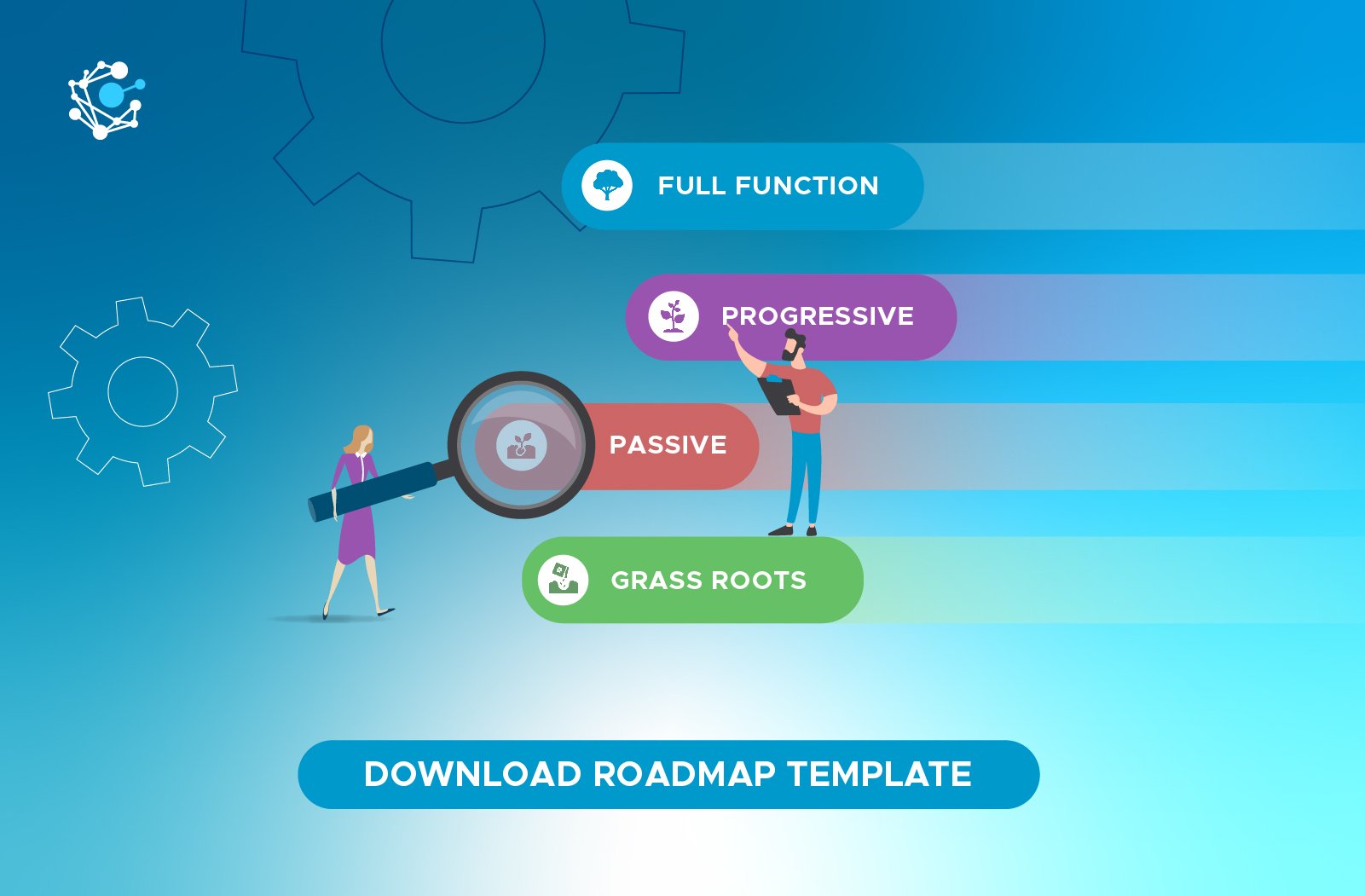
.webp)

